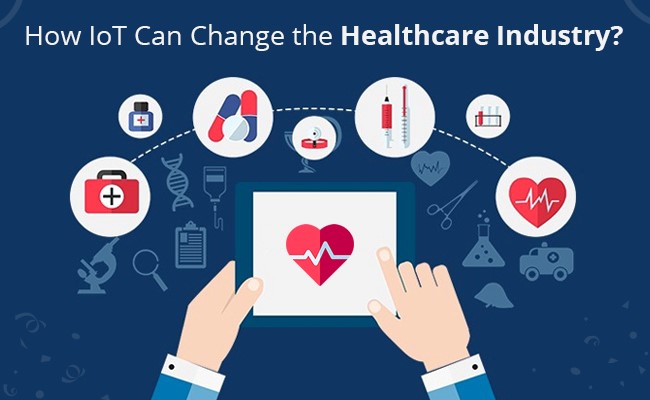Internet of Things (IoT) enabled devices to allow healthcare professionals to make remote monitoring of patients, keep patients safe and healthy, and empowering to deliver superlative care. IoT increases patient engagement and satisfaction as interaction with doctors is much easier. In IoT, remote monitoring of patients helps to reduce the length of hospital stay. Internet of Things reducing healthcare costs remarkably and also improving treatment outcomes. IoT boosts productivity and improves healthcare quality. By 2020, the expected market of IoT in healthcare would be $117 billion. IoT offers real-time monitoring of patients and dispenses quicker and more effective treatment. IoT allows access to information faster and offers high-quality care of the patient.
Today, with the impeccable support of Healthcare software companies, the Healthcare Industries is making a stunning impact in their business works and almost 80 percent of their hospital-based works are performed through smart devices.
The major advantages of IoT in the healthcare include: cost reduction, improve treatment, faster disease diagnosis, proactive treatment, drug, and equipment management, and error reduction through IoT devices. IoT devices are generally tagged with sensors that are used for tracking the real-time location of medical equipment like nebulizers, oxygen pumps wheelchairs, defibrillators, and other monitoring equipment. IoT applications help in patient engagement and consistently play an important role in relationship management with healthcare providers and payers.
Data Management
IoT devices provide the best possibilities of gathering relevant information about patients in on-site and outside of the medical premises. Telemetry that captures the data and communicates it automatically and remotely. IoT devices allow the healthcare industry to collect, analyze, and report the data in real-time. Doctors directly get access to the final reports with graphs. IoT devices offer data-driven insights and robust healthcare analytics that are less prone to errors and also help to speed up decision-making.
Remote Patient Monitoring
IoT devices offer remote patient monitoring which is basically the most significant cost-reduction feature in healthcare. With the help of remote patient monitoring, you can cut down the daily cost of on-site patient servicing. Hospitals don’t need to worry about bed availability and also doctors can keep eye on their patients remotely as a result patients feel more relaxed at home and recover faster.
Efficient Drug Management
One of the expensive units in the healthcare industry is drug management. From the drug testing to launch every process can be made efficient with the help of IoT. Drug distribution can be managed through digital tags that allow incessant control over the process.
Streamline the Workflow
IoT can help organizations in streaming their processes and optimize their workflow. IoT technology gives healthcare professionals the power to collect, view, analyze, and transfer the data faster than before. Hospitals can identify their patients by using wrist band tagging technology. IoT integrated devices help medical staff to identify and diagnose health issues more quickly than before.
According to the Allied Market Research currently, there are 3.7 million devices that are used to collect and monitor health data. By 2021, the Internet of Medical Things market size is expected to reach $136.8 billion worldwide. It was expected by the year 2020, 40 percent of IoT devices will be getting used in the Healthcare Industry. The day is not far when the Healthcare Industries consult Healthcare software companies to implement IoT based business solutions for their industrial works.
Helpful to encourage physical health
Rather than sticking to the exercise regimes to track your fitness
Some significant IOT based devices such as Apple Watch and Fitbit eliminates the need to stick on to the yearly physical exams to follow the perfect exercise regimes. These devices help in tracking the physical activities, metrics and notify us about the number of miles or steps we walk per day. The fitness tracker on the wrist reminds us to focus on physical health and self-awareness through the activities. Not just these, the IoT based devices also help us in caring about our personal sleep hygiene and boost up our mind.
How IoT is helpful in the treatment process?
In fact, IoT also helps in the treatment of diseases by targeting them through the improved treatment process.
For instance, an IoT based device called CYCORE assists in a great way while treating cancer patients. This monitoring system shares updates about the patient’s symptoms to the physicians by which they can easily identify the issues in no time.
IoT helps in monitoring the Infant Health
Pacif-I, an IoT based device assists in measuring the infant’s body temperature and helps parents and doctors to monitor the illness for proper treatment.
Another important IoT based device is the IBM Watson baby movement monitor. This provides the clues of baby movement, sleeping activities by using sensors and helps to cover the baby’s needs.
Conclusion:
The emerging Smart technologies have made a huge difference in the healthcare industries and joined hands in saving millions of lives. Among these, the IoT is leading the list which helps in all the possible ways in preventing health issues. This is what people expect generally when it comes to the question of lives.
Author Bio:
Hi, I am Kapil Panchal, working as a Digital Marketing Manager in a reputed Healthcare Software Development Company. Being a Technical Writing Enthusiast and a goal-oriented individual with honed communication skills, I have years of experience in the Information technology, Services, and Product industry. Having a high-energy level, I absolutely love what I do and I’m passionate about being better every day.
